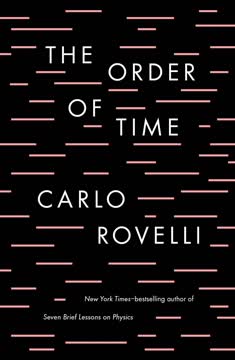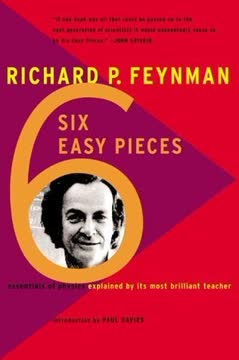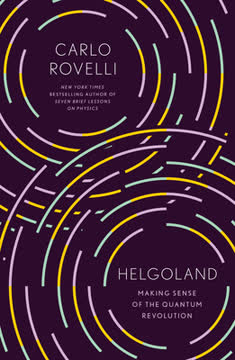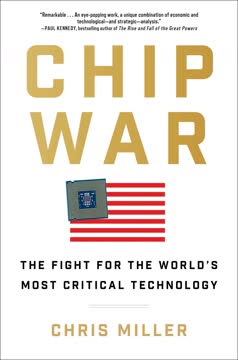Key Takeaways
1. Classical Computing: Logic with Balls
Obviously our lives have already been revolutionized by computers and the many related technologies all based upon the same basic principles of micro-electronics.
Computers use simple rules. Modern computers, from your phone to supercomputers, operate based on simple, fundamental rules applied to binary states (like black or white balls, or high/low voltage). These rules, such as NOT, CNOT, CSWAP, and CCNOT, are universal and can be combined to perform any classical computation. They essentially implement basic logical operations.
Logic from matter. These simple rules for manipulating physical states (like ball colors) directly map to fundamental concepts of logical thinking. For instance, the CCNOT box can compute the logical AND operation, and with other gates, you can build OR, IF-THEN, and other complex logical structures. This connection shows how the motion and interaction of matter can embody the logic we use in thought and computation.
Building complexity. By stacking and combining these basic "computer rules" boxes, we can create incredibly complex systems. The vast diversity of computational tasks, from running video games to managing global networks, arises from the intricate arrangement and application of these simple, universal logical gates on binary inputs. This demonstrates how simple rules can generate unbounded complexity.
2. Introducing the PETE Box and Superposition
However, when we stack two PETE boxes, something remarkable happens: if we drop a white ball in the top of the first PETE box it always emerges white from the bottom of the second box.
Randomness and paradox. The PETE box is a device that, when a black or white ball is dropped in, outputs a randomly determined color (50% black, 50% white). However, stacking two PETE boxes results in a predictable output: a white ball always emerges white, and a black ball always emerges black. This is paradoxical because if the first box outputs a random color, the second box should also output a random color, regardless of its input.
Observation changes outcome. The paradox deepens when we try to observe the ball between the two PETE boxes. If we look at the ball after the first box, it is indeed randomly black or white, and the second box then behaves randomly again. If we don't look, the predictable outcome returns. This implies that the act of observation fundamentally changes the process, preventing the predictable two-box behavior.
Failure of classical logic. This behavior challenges classical logic. If the ball exiting the first PETE box is either black or white, then the second box should act randomly. If it's both black and white, that's intuitively nonsensical for a single ball. The classical notion of a ball having a definite, albeit unknown, color fails to explain the two-box experiment.
3. Superposition: A New State of Being
Confronted with this conundrum, physicists simply invented a new word to describe the ball after it exits the PETE box.
Beyond 'or' and 'and'. To describe the state of the ball after one PETE box (when unobserved), physicists introduced the concept of "superposition," or a "misty state." This is not the classical idea of the ball being either black or white (where we just don't know which), nor is it the nonsensical idea of it being both black and white simultaneously in the classical sense.
Representing the mist. Superposition is represented diagrammatically as a cloud containing the possibilities, like [White, Black]. A key feature is the introduction of negative signs, like [White, -Black], to distinguish different types of superpositions that behave differently when processed further. These signs are not observable properties of the ball itself but are crucial for calculation.
Interference and cancellation. When a misty state passes through boxes, the rules are applied to each configuration within the mist. If identical configurations with opposite signs (-1 and +1) appear in the resulting mist, they cancel each other out through "interference." This interference is what explains the predictable output of two stacked PETE boxes, as certain configurations (like black emerging from a white input) are eliminated.
4. Quantum Computing's Power: Beyond Classical Logic
Regardless of what they are, a suitably built computer will be able to utilize misty states to do certain computations in vastly fewer steps than regular computers would require.
New computational logic. Incorporating PETE boxes allows computers to operate using the logic of misty states, which goes beyond standard classical logic. While classical computers process one definite state at a time, misty computers can process superpositions of states simultaneously. This parallel processing within the mist is a key source of their power.
Exponential advantage. For certain problems, misty computers offer an exponential speedup over the best possible classical computers. The Archimedes example shows how a misty computer can solve a problem (determining vault type) in one step, regardless of the number of gold bars, while a classical computer might take an impractically long time. This isn't just faster processing; it's a fundamentally different approach to computation.
Tackling intractable problems. The real excitement of misty computers lies not in speeding up current tasks, but in making previously impossible problems tractable. They can tackle complex simulations (like molecular interactions for drug discovery) or advanced machine learning that are far beyond the capabilities of even the largest supercomputers. While they don't compute the "uncomputable," they vastly expand the set of problems we can solve in practice.
5. Entanglement: Linking Distant Balls
Misty states of two or more balls can be “entangled,” by which we mean they cannot be treated as if they have independent colors, or independent misty states for that matter.
Beyond individual mists. While single balls can be in superposition (a misty state), multiple balls can be in a special kind of misty state called "entanglement." An entangled state of two or more balls cannot be described as simply combining the individual misty states of each ball separately. It represents a holistic state of the combined system.
Non-separability. Entangled states are "non-separable." This means the properties of the individual balls are linked in a way that transcends their individual descriptions. For example, the Bella mist [WW, BB] of two balls is entangled because it cannot be formed by combining separate misty states for ball 1 and ball 2 (like [W,B] and [W,B]).
Preparation requires interaction. Entangled states, unlike simple combinations of mists, must be created through interaction between the particles. Once created, however, the entanglement can persist even when the particles are separated by vast distances, provided they remain unobserved in a way that would destroy the mist.
6. Nonlocality: Correlations Defying Explanation
We can perform far-separated, well-shielded experiments (observations) on balls in a misty state, the outcomes of which are inextricably linked, in as much as they cannot be reproduced by physical stuff (whatever it is) responding only to what is going on around it locally.
Spooky correlations. Entangled particles exhibit "nonlocal correlations." This means that when measurements are made on entangled particles separated by a large distance, the outcomes are correlated in a way that cannot be explained by classical physics or any local hidden variables. The outcome of a measurement on one particle seems linked to what is happening to the other, even if there's no time for communication between them.
Beyond classical correlation. Classical correlations (like two boxes guaranteed to contain balls of the same color) can be explained by the particles having definite, pre-existing properties (e.g., both balls were always red). Nonlocal correlations, however, cannot be explained this way, as demonstrated by experiments like the psychic game. The outcomes are linked in a way that defies the idea of independent, local reality.
Experimental verification. These nonlocal correlations are not just theoretical curiosities; they have been repeatedly verified in experiments using quantum systems like photons or electrons. The results consistently show correlations stronger than any classical theory based on local realism can explain, pointing to a fundamental strangeness in how reality works at the quantum level.
7. The Psychic Game: Winning with Entanglement
The answer, as you may have guessed already, involves misty states of balls somehow.
A test of nonlocality. The psychic game is designed to test whether Alice and Bob, separated and unable to communicate, can coordinate their answers better than chance allows while obeying specific rules. Classically, no strategy (deterministic or random) can guarantee wins while always obeying the rules; there's always a risk of being caught cheating if they try to win.
Entanglement provides the edge. Alice and Bob can win the game reliably and obey the rules by using pairs of entangled balls, one for Alice and one for Bob, prepared in a specific entangled state (like [WW, WB, BW]). Their choice of measurement (direct observation or via a PETE box) depends on the coin flip they receive.
Quantum strategy succeeds. When both get tails, they both use a PETE box, and the entangled state evolves such that the BB outcome (their winning condition) is possible, while rule-breaking outcomes are cancelled by interference. For other coin combinations, their measurement choices ensure rule-breaking outcomes are impossible. This quantum strategy allows them to succeed where any classical strategy would fail or risk being caught.
8. Nonlocality Challenges Classical Causality
The conclusion of all this is that if you want a causal explanation of the nonlocal correlations we observe, then it has to be a very strange explanation in its own right.
Defying local causes. Nonlocal correlations challenge our intuitive understanding of cause and effect. In classical physics, causes are local and propagate through physical intermediaries at finite speed (at most, the speed of light). The correlations in entangled systems appear instantaneous and independent of distance.
No faster-than-light communication. Despite the apparent instantaneous link, nonlocality cannot be used to send messages faster than light. While Alice's measurement choice affects the set of possible outcomes for Bob's particle, she cannot control which specific outcome Bob gets. Bob's observed probabilities remain the same regardless of Alice's choice, preventing him from decoding a message.
Questioning fundamental assumptions. The existence of nonlocal correlations forces us to question deeply held assumptions about reality:
- Locality: Events here are only influenced by their immediate surroundings.
- Realism: Physical systems have definite properties independent of observation.
- Freedom of choice: Experimenters can make independent choices about measurements.
Giving up any one of these leads to profound philosophical implications about the nature of the universe.
9. The Misty State: Real Property or Just Knowledge?
It is fascinating that we have this incredibly precise theory, which, as we shall see, is going to let us build marvelous new useful devices, and yet we are still arguing about what it all really means.
Mathematical tool vs. physical reality. The misty state is undeniably a powerful mathematical tool for predicting experimental outcomes in quantum mechanics. However, there is significant debate among physicists about whether the misty state represents a real physical property of a system itself, or if it is merely a description of our knowledge or information about the system.
Analogy to rocky states. The concept can be compared to the "rocky state" of a coin flip, which represents our knowledge (e.g., 50% heads) but is not a physical property of the coin affecting its trajectory. If misty states are like rocky states, they are in our minds, not inherent to the physical object.
Misty states as real properties. One view is that the misty state is the real physical state of the system. This provides a natural explanation for why devices like the PETE box seem to respond to the mist. However, this view faces significant challenges, particularly regarding the process of observation.
10. The Problem of Collapse Upon Observation
It is difficult to convey how repulsive most physicists find such “jumping.”
Instantaneous, discontinuous change. If the misty state is a real physical property, then the act of observation causes this real state to "collapse" or "jump" instantaneously and discontinuously into a definite classical state (like black or white). This is unlike any other process in classical physics, which are typically continuous, even if very fast.
Observer dependence. The collapse seems to depend on the presence of an "observer" or a measurement capable of revealing the classical property. The physical mechanism of observation doesn't seem to matter, only its ability to distinguish the classical states. This raises the question of what constitutes an "observer" and why they play such a special role.
Nonlocal collapse. For entangled states, observing one particle can instantaneously collapse the entangled misty state across vast distances, seemingly affecting the real state of distant particles. This "spooky action at a distance" is a major source of discomfort for those who view the mist as physically real, as it violates our intuition about local causality.
11. The Debate on Reality: Einstein vs. Pooh-Bear
Einstein claims to prove there is an overlap between the real states corresponding to two or more misty states, and thus he concludes the “value of the mist” cannot be “on the paper”—it is not a physical property, it is not part of the “real physical state” of a ball.
Einstein's argument (Mist is not real). Einstein argued that if (i) a real state of a particle exists, and (ii) distant actions cannot instantaneously affect this real state (locality), then a single real state must correspond to multiple different misty states. Since a real state should uniquely determine all physical properties, this overlap implies the misty state is not a real physical property, but rather a description of knowledge.
Pooh-Bear's argument (Mist could be real). The "Pooh-Bear" argument, based on a different assumption, reaches the opposite conclusion. It assumes that if two systems have never interacted, they have independent real states. This leads to the conclusion that each real state must correspond to one and only one misty state. This unique mapping means the misty state could be a real physical property.
Unresolved interpretation. The conflict between these arguments highlights the deep interpretive challenges of quantum mechanics. While the mathematical framework of misty states makes incredibly accurate predictions and enables new technologies, there is no universally accepted narrative about what is "really" going on at the fundamental level. The debate over whether the mist is real, or just a tool for describing our knowledge, continues.
Last updated:
Review Summary
Q is for Quantum receives mixed reviews, with ratings ranging from 1 to 5 stars. Some readers appreciate the author's attempt to explain quantum concepts using simple language and analogies, praising its accessibility for beginners. Others find the simplified approach and invented terminology confusing or oversimplified. Critics argue that the book lacks proper connection to standard quantum theory vocabulary, potentially hindering further study. While some enjoy the author's humor, others find it distracting. Overall, the book seems to divide readers based on their prior knowledge and expectations.
Similar Books
Download PDF
Download EPUB
.epub digital book format is ideal for reading ebooks on phones, tablets, and e-readers.









